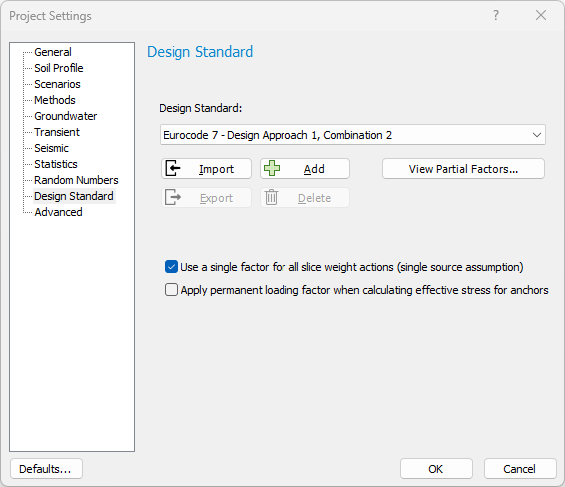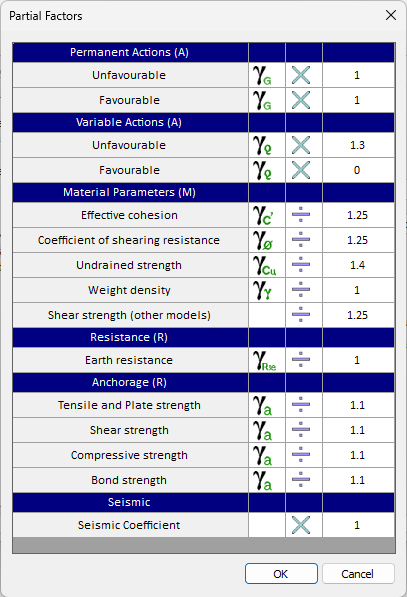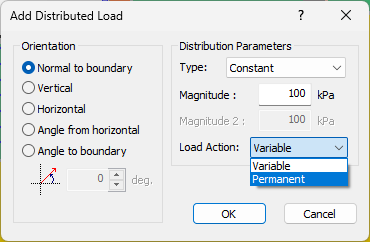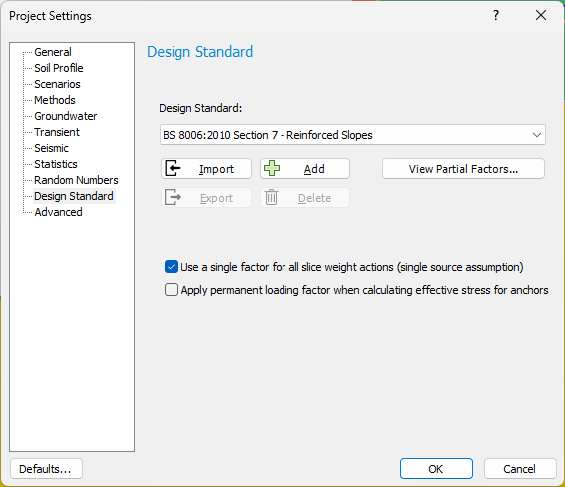Design Standards
Which design standards are supported in Slide2?
Slide2 currently supports the following standards:
- Eurocode 7 (EC7)
- British Standard (BS) 8006
- AASHTO 2020
- AS4678-2002
The loading and resistance factors stipulated in the codes are automatically applied to the forces and material properties during the analysis of the factor of safety.
Specifying a Design Standard
To specify a design standard for analysis, go to Project Settings > Design Standards. Here you can select from a list of supported design standards along with their associated combinations of partial factors. The partial factors can be viewed by clicking View Partial Factors.
You can also define your own list of partial factors by clicking the Add button, and then selecting an existing standard as a base. These lists can also be imported and exported between Slide2 models.

What are Partial Factors?
Factors must be applied to the loading and resistance components of the slip surface analysis per design standard. These factors serve to amplify the actions inducing the slope failure and/or reducing the capacity of resisting materials. Different factors are applied to different components of the analysis – hence the term “partial” can be used to describe them.
Eurocode 7:
Driving is Multiplicative (New value = Original Value x Factor):
- Permanent Actions (A)
- Variable Actions (A)
- Seismic
Resistance is Divisive (New value = Original Value / Factor):
- Material Parameters (M)
- Resistance (R)
- Anchorage (R)
British Standards:
Driving is Multiplicative (New value = Original Value x Factor):
- Soil Unit Mass
- External Dead Loads
- External Live Loads
- Seismic
Resistance is Divisive (New value = Original Value / Factor):
- Material Parameters
- Resistance
- Reinforcement
AASHTO Standards:
Driving is Multiplicative (New value = Original Value x Factor):
- External Dead Loads
- External Live Loads
- Seismic
Resistance is Multiplicative (New value = Original Value x Factor):
- Reinforcement
Australian Standards:
Driving is Multiplicative (New value = Original Value x Factor):
- External Dead Loads
- External Live Loads
- Seismic
Resistance is Multiplicative (New value = Original Value x Factor):
- Material Parameters
- Reinforcement
In some standards, separate factors are required depending on whether a particular force in the analysis is favourable or unfavourable with regards to preventing the slip surface from mobilizing.
A sample list of partial factors from the BS 8006: 2010 is provided below.

Specifying Applied Loads
If a design standard has been specified in Project Settings > Design Standards, then the interface for adding Distributed Loads and Point Loads to the model will have an option to specify whether an applied load is Variable or Permanent (Live and Dead, respectively). Depending on the selection and, if applicable, whether the load is favourable or unfavourable to prevent sliding of the slip surface, Slide2 will automatically apply the appropriate partial factor(s) during the analysis.

Single Source Assumption
It is important to note that distinguishing whether a load is “favourable” or “unfavourable” can sometimes be ambiguous. In particular, the weight of soil above the slip surface can be partitioned into unfavourable and favourable regions, such as in the example below, where Wf is the favourable weight of soil and Wu is the unfavourable weight of soil. The slices to the right of the dashed line will instigate sliding while the slices to the left will react against sliding.

In such a case, it may be appropriate to use the “single source assumption”, which applies the unfavourable factor to the entire soil mass, regardless of location. Since the soil weight arises from a single source, it may not be appropriate or realistic to apply different factors to different portions of the same component or “source”. This assumption is discussed in Bond et al. (2013).
This single-source assumption can be toggled during the selection of a Design Standard via the “Use a single factor for all slice weight actions” checkbox. If the checkbox is toggled ON, Slide2 will assume the value of the unfavourable partial factor for Permanent Actions for ALL slices. If it is toggled OFF, then the dip direction of a slice will determine whether the weight of that slice is favourable or unfavourable.
Factoring Soil Weight
The weight of soil in a slice affects many of the terms in the calculation of factor of safety in a slip surface, which are often inter-dependent. These terms include the base normal and shear force for each slice, forces applied on anchors, and pore pressure. As such, there is ambiguity in some design standards with regards to whether the favourable or unfavourable factors of soil weight should be applied for each specific component of the analysis. Specifically, in Eurocode 7, there are two factors for soil weight: γγ which reduces the soil weight and γG which increases the soil weight.
In the Limit Equilibrium Method (LEM), soil weight has a transcendental relationship with the equilibrium forces used to solve for the factor of safety and thus cannot always be separated into terms which can specifically be designed as actions or resistances in the force balance equations or can be factored in specific ways (e.g. AS4678-2002 recommending to factor effective earth pressure after deducting pore pressure from total stress). With exception to anchor calculations (described in the next paragraph), the weight of soil for a given slice is thus generally taken as a single value in Slide2. This means the same value of weight is used to calculate all contributions (base normal and shear forces, pore pressure, etc.) to the analysis. For this reason, factors such as γγ will be applied globally (i.e. directly to the input values in the Material Properties dialog). If the single source assumption is used, then this single value is the “unfavourable” factored value for every slice, even though a higher value of soil weight may increase the resisting frictional forces. If the single source assumption is not used, then the factor for each slice will depend on the dip direction of its base.
For anchor calculations, by default, the factors for permanent applied loading (e.g. γG in EC7 and ffs for BS8006) are not considered during effective stress calculations as these unequivocally increase the effective stress and result in non-conservative anchor forces. However, this can be toggled by checking the “Apply permanent loading factor when calculating effective stress for anchors” checkbox, shown in the interface below. Note that as explained above, for Eurocode 7, the material resistance factor for unit weight, γγ, will always be applied to reduce the weight of soil above the anchor.

Factoring Support Capacity
When specifying support capacities in Slide2, there are a few different ways to define partial factors. the Custom Partial Factors option. If you want to use a geosynthetic manufacturer and the associated factors, you can use those instead. Use the Design Factors tab in the support dialog to see or change which factors are being applied to your support. See the Support Implementation page for more details.
- Factor for “Shear strength”: applied to the lateral reaction
- Factors for “Compressive strength” and “Tensile and Plate strength”: applied to the axial reaction, depending on whether the pile is in compression or tension.
- Factor for “Bond strength”: not available as an option.
- Factor for “Sliding resistance”: not available as an option.
REFERENCES
Bond, A.J., Schuppener, B., Scarpelli, G. and Orr, T.L.L. (2013). Eurocode 7: Geotechnical Design Worked Examples. [workshop presentation] Luxembourg: Publications Office of the European Union, pp. 16-31.